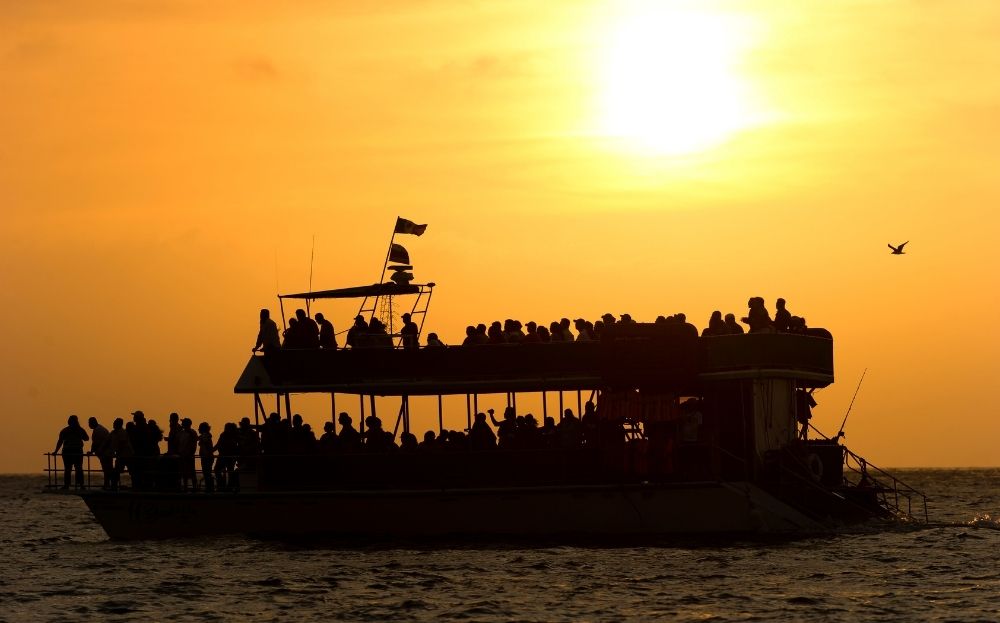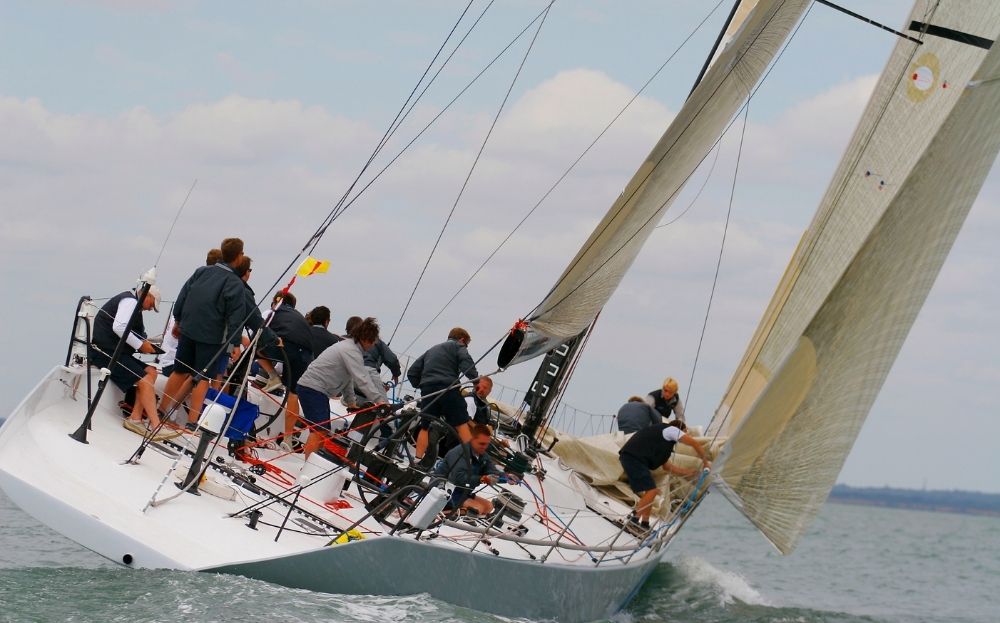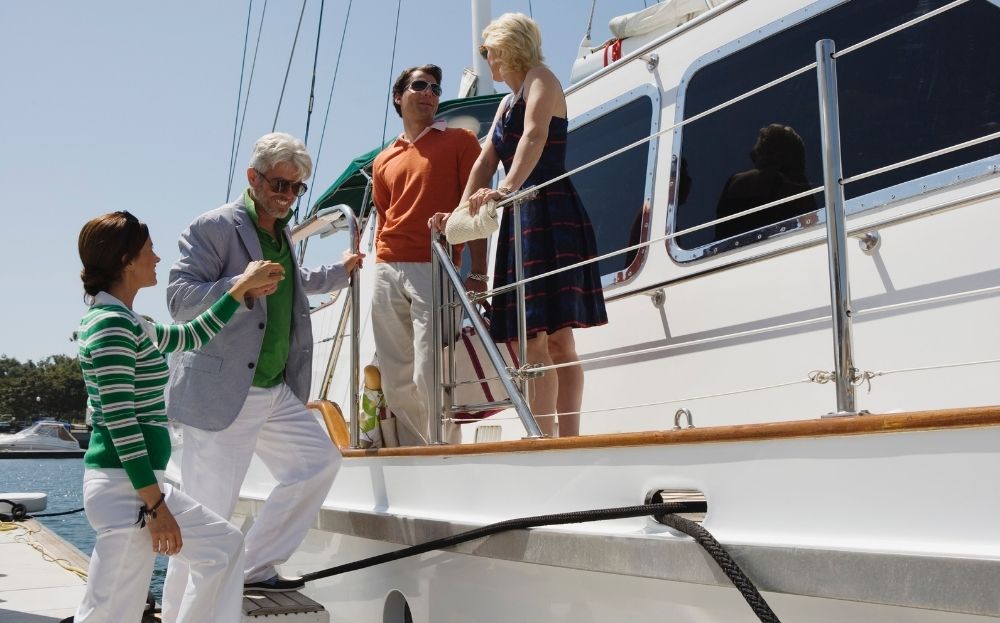Simply put, the best way to avoid overloading your boat is to not load it beyond the limit US federal law advises.
The US federal law will only want you to load within a limit, but avoiding overloading your boat is also important to keep yourself and your passengers safe whilst on the water.
A boat can only hold a certain amount of weight and remain stable, anything above this will cause the boat to become unstable and capsize.

We have written this article to tell you the best way to avoid overloading your boat which could lead to dangerous situations and we also look at ways to keep everyone safe. Let’s dive right in!
Boat Load
Boat rides and the number of people at sea are increasing every day.
Whether that’s a big around-the-world cruise, a boat party on the river, recreational activities, or a solo trip up the canal, whatever your reason is for being out on the waves, you need to ensure you are following proper water safety rules and be prepared for any event with essential boat life-saving accessories.
In most cases, people at sea tend to follow the guidelines and rules set out about overloading their boats.
However, there are still several sailors out there who ignore this and still overload their boats or even overpower them with higher-power motors.
This can make the boat unstable when traveling at high speeds and consequently can significantly increase the risk of an accident.
Though these people might seem reckless or purposefully ignore guidelines, a lot of people do it by accident and are just not aware of what the guidelines are!
A boat is designed to only carry a certain number of passengers, the weight of cargo, and its machinery safely in different sailing conditions.
For example, a boat can carry a lot more weight if it is sailing at slower speeds in calmer weather, than at higher speeds in heavy currents or stormy conditions.
So, what is the best way to avoid overloading your boat and keep you safe for the conditions you are sailing in?
Avoiding Overloading Your Boat
Following The Capacity Plate
Most major boats have an instruction plate with them that is known as the capacity plate. This is placed at the helm or the boat stern and is made of metal.
It indicates critical boat parameters such as maximum speed, capacity, engine horsepower, passenger capacity, and many other technical details ranging from the batch and model number to the serial number and other information.
The US coast guard has made it compulsory for every boat manufacturer to install a capacity plate at the helm of boats smaller than 20 feet in length.
If you do not follow the limitations on the plate, the boat can become unstable and difficult to control. You will also be directly violating federal laws in many US states.
Before you take to the sea, make sure you are aware of the maximum passenger and weight limit on the capacity plate.
You need to know the total weight capacity of the boat is irrespective of how many passengers it can carry and the weight of any machinery.
There is no time where you should exceed the weight or passenger limit and if you follow these rules, you will be able to avoid overloading your boat.
The information contained in a capacity plate will differ depending on the type of boat. Your capacity plate might have depending on boat type:
- Boats Powered By Outboards Capacity plates indicate the maximum passenger capacity in pounds and the maximum weight capacity in pounds, as well as the maximum horsepower.
- Inboard-and Stern Drive-Powered Boards The capacity plate indicates the maximum passenger capacity in pounds and persons, as well as the maximum weight capacity including gear in pounds.
- Manually Propelled Boats- These boats have a capacity plate that indicates the same information as the previous category. Maximum passenger capacity in pounds and maximum weight capacity for passengers and gear.
On each capacity plate, you should always have the maximum passengers, the maximum gross load, the passenger capacity, the capacity of other items on board such as motor and gear, and the maximum horsepower.
Check Water Conditions
If you load your boat beyond the safe limit, it will become unstable in the water, and this is what makes it so dangerous.
The amount of weight you add to any boat will affect stability in any condition, however, it’s important to note a boat is always more stable in seawater than in rivers or freshwater lakes.
This is a result of the salt concentration. This concentration in seawater aids the boat in floating and becoming stable by increasing the water density.
This means you can add weight to your boat to its limit, whilst still beefing safe and secure. This is the reason why on some boats, you might find different limits for both fresh and seawater.
Your boat stability is also affected by the weather conditions. You are likely to be less safe when you have loaded your boat to the limit in rough seas than in calmer, sunnier weather.
When you are blessed with calmer weather, this is when your boat is stable and safest. This is what the capacity plate readings are linked to as well.
Ensuring Stability
If you are wondering why the sitting space is spread across the boat, this is to ensure overall boat stability.
Regardless of how big or small your boat is, you will find every boat has dedicated space in the front, middle, and back for different purposes.
This is done so that the weight gets evenly distributed along the total length of the keel. If the weight is unbalanced across the boat, this will mean it will automatically start to lean to one side.

While a slight lean in the water is normal for most boats, if you find your boat is leaning too much to one side, you will know it’s not safe enough to hit deeper waters.
By redistributing weight, you can ensure the stability of the whole boat and to do this, simply try putting heavier items closer to the center.
Moreover, if you want to keep your boat stable even when going at high speeds and taking sharp turns, it’s a good idea to install a hydrofoil on the outboard of your boat.
This will help boost boat performance, efficiency, and also level your ride at higher speeds. It will force the bow to go down and stern a little to improve the overall safety and boat experience.
Check The Manual
Instead of a capacity plate, bigger boats often come with a user manual instead.
This usually contains information such as the basic layout of your boat, the electronic information, information about the boat engine, and the safe loading capacity.
You will not only find the loading compartment on a boat but also how much load each one can hold.
From the general manual, you can find out about the specification of your boat such as bridge clearance, tank capacity, freeboard, draft, LOA, kneel length, and much more.
If your boat does not have a capacity plate at the helm, you should also find the capacity plate information in the first couple of pages.
Some manufacturers also give separate safety manuals for their boats which provide information on the safe practices of operating and loading the boat.
These manuals deal with alternate topics to keep you and your passengers safe onboard such as your responsibility on the boat, the boating equipment, the passengers, and everyday safety checks you should perform before setting off and after you arrive back from your boating trip.
Create Your Own Passenger Limit
If your boat does not come with a capacity plate, you can come up with your passenger limit if you know the length and width of your vessel using a special formula.

This is especially helpful if you cannot have the manual on you at all times.
The formula to create your passenger limit will only work if you know the area of your whole boat. To do this, use the length x width calculation.
You then need to divide the area by 14-16. Use 14 when the sea is much calmer than usual, 15 for calm fresh water and 16, if there are milder winds, or you plan to test high speeds.
When you get your final value, you will then need to round off to the closest integer. 6.89 will become 7, 6.23 will become 6, and whilst calculating the number of passengers, you will need to count each adult as 1, and each child as 0.5.
Avoid Overpowering Your Boat
We know how fun it can be to get your boat sailing at higher speeds and there is no danger in checking your limits and vessels if you do so safely.
However, people often go too far with this and add high-power motors to boats, a lot more powerful than the boat can handle.
As you increase the acceleration on the boat, the speed will make it relatively unstable and unsafe.
If you want to power your boat safely and reach those higher speeds, you need to make sure the destabilizing forces are within the limit and you have balanced your boat for stability.
However, there is a limit to what your boat can neutralize with these forces and this depends on the size of the vessel.
As the size of your boat is fixed, the upper limit of acceleration and speed it can withstand is also fixed. This is why most capacity plates have the maximum horsepower for that particular boat.
If you give your boat too much power with larger power motors, you are only making it unstable as you will find it much harder to control when it reaches those top speeds during acceleration.
If you do this, the boat will lean to one side or lift off from the bow which causes high-speed boating accidents.
Plan, plan, plan
Planning is essential when it comes to the sea, always. The simplest and best way to avoid overloading is to make sure you have planned your whole trip.
Many times we might take too much stuff than we need or extra people since we did not plant to the boat capacity and this can lead to significantly overloading.
If you fail to plan and leave everything to the last minute, you do not allow for even weight distribution and will end up carrying unhelpful and unnecessary items and will make the boat unstable.
If we simply remember to plan ahead, we can avoid overloading and make the time to prioritize what we need.
If you fail to do so, you might not only end up taking too much, but you also might end up forgetting things and taking too little.
Planning helps you keep a safe and acceptable position away from the shore, but ensure you have bought all the right accessories and equipment for a successful trip.
When you sit down to plan, you need to follow the instructions mentioned in the owner’s manual or capacity plate installed at the boat helm, and this will avoid overloading.
When you are finalizing the plan, categorize things based on weight and how much you need them and then store them in this order on the boat.
Moreover, rather than all sitting down in one place, try and take up positions spread all over the boat. This will help to distribute the weight evenly.
Final Thoughts
So what is the best way to avoid overloading your boat? Simply put, plan ahead, distribute the weight and always stay within the limits on your manual or your boat capacity plate!
If you want to work out your passenger capacity, follow the formula in this article and never exceed that number.
If you follow all of these rules in place to keep you safe, you should be on your way to a super fun trip out at sea. Happy sailing and stay safe!
- Sustainable and Luxurious: Discovering Split’s Yachting Paradise – April 26, 2024
- MarineTraffic vs VesselFinder: Which Is Better Vessel Tracking Service? – February 14, 2024
- Port Costs: A Comprehensive Guide to Port Dues and Fees for Cargo Ships – February 12, 2024





Leave a Reply